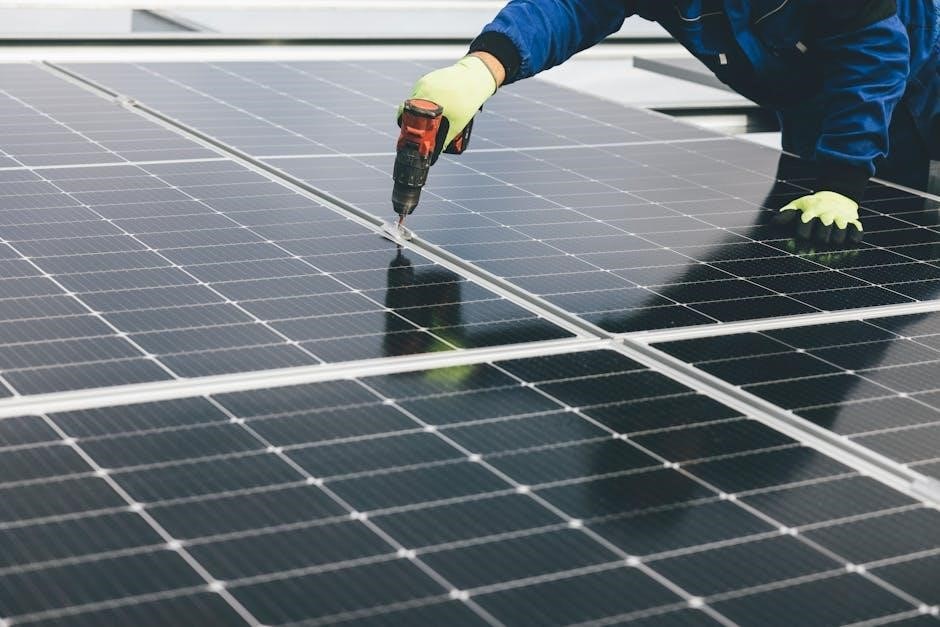This section introduces solar PV engineering and installation, highlighting Sean White’s book as a comprehensive guide covering engineering principles, system design, installation, and safety protocols for NABCEP certification preparation.
1.1 Overview of Solar PV Technology
Solar PV technology converts sunlight into electricity using photovoltaic cells. It involves solar panels, inverters, and mounting systems to generate clean energy. This renewable energy source reduces reliance on fossil fuels, offering environmental benefits. Sean White’s book provides a detailed overview, covering engineering principles, system design, and installation practices, preparing readers for NABCEP certification and practical applications in the field.
1.2 Importance of Solar PV in Renewable Energy
Solar PV is a cornerstone of renewable energy, offering a sustainable and scalable solution to reduce carbon emissions. It complements other renewables, enhances energy security, and supports global climate goals. Sean White emphasizes its role in transitioning to a low-carbon future, highlighting its potential to meet growing energy demands while promoting environmental and economic benefits, as detailed in his comprehensive guide.
1.3 Brief Biography of Sean White
Sean White is a renowned expert in solar PV engineering and education, recognized with prestigious awards like the 2014 IREC 3i Award and the 2011 Mike Holt Instructor of the Year. He has served on the NABCEP PV Installation Professional Technical Committee, sharing his expertise through teaching and authoring influential resources like Solar PV Engineering and Installation, a key guide for certification preparation.

Key Features of the Book by Sean White
Sean White’s book is a second edition, published in 2019, offering in-depth preparation for NABCEP certification exams, covering PV engineering, installation, design, and real-world applications in digital formats.
2.1 Purpose and Scope of the Book
The primary purpose of Sean White’s book is to provide comprehensive preparation for the NABCEP PV Installation Professional certification exam. It covers essential topics in solar PV engineering and installation, including system design, safety protocols, and practical applications. The book serves as a detailed guide for professionals seeking to excel in the solar industry, offering both theoretical knowledge and real-world insights.
2.2 Target Audience for the Publication
The book is designed for solar PV professionals, including installers, engineers, and designers, preparing for NABCEP certification. It also serves as a valuable resource for students and individuals transitioning into the solar industry, providing foundational knowledge and practical insights essential for success in solar PV engineering and installation.
2.3 Unique Aspects of the Second Edition
The second edition of Sean White’s book offers updated content on NABCEP certification preparation, including expanded coverage of solar PV system design, advanced installation practices, and new technologies. It also features enhanced exam preparation strategies and real-world case studies, providing readers with a comprehensive and modern approach to solar PV engineering and installation.
Preparation for NABCEP Certification
Sean White’s book provides detailed preparation for the NABCEP PV Installation Professional Exam, including exam strategies, practice questions, and real-world applications to ensure success in certification.
3.1 Overview of NABCEP Certification
NABCEP certification is the gold standard for solar PV professionals. Sean White’s guide covers exam preparation, including design, installation, and safety. It serves as a comprehensive resource for PV Installation Professional and Specialist exams, ensuring industry-standard expertise and compliance. The book’s focus on real-world applications and emerging technologies makes it an essential tool for certification success.
3.2 PV Installation Professional (PVIP) Exam Details
The NABCEP PV Installation Professional (PVIP) Exam is the gold standard for solar PV professionals, known for its difficulty. Sean White’s book is tailored for this exam, covering design, installation, and safety. It also addresses Specialist Certification Exams, ensuring comprehensive preparation. The PVIP Exam focuses on real-world applications, making it a critical step for industry professionals seeking certification and expertise in solar PV engineering.
3.3 Specialist Certification Exams Covered
Sean White’s book also covers material for NABCEP Specialist Certification Exams, such as Design Specialist and Installer Specialist exams. These exams focus on advanced topics like system design, installation techniques, and commissioning. The book provides detailed insights and preparation strategies for these specialized certifications, ensuring professionals can excel in specific roles within the solar PV industry.
Solar PV Engineering Fundamentals
This section covers the basic principles of solar PV systems, components, and essential design considerations, providing a foundational understanding for engineers and installers.
4.1 Basic Principles of Photovoltaic Systems
Photovoltaic (PV) systems convert sunlight into electricity using semiconductors. The process involves PV cells generating DC power, which is then inverted to AC for practical use. Key principles include understanding light absorption, charge separation, and energy conversion efficiency. Sean White’s book explains these fundamentals, detailing how PV cells, modules, and inverters work together to form functional systems. This knowledge is essential for designing and installing efficient solar PV setups.
4.2 Components of a Solar PV System
A solar PV system consists of PV modules, inverters, mounting structures, wiring, and monitoring systems. PV modules capture sunlight, inverters convert DC to AC power, and mounting systems secure panels. Wiring connects components, while monitoring systems track performance. Sean White’s book details these components, emphasizing their roles in ensuring efficient and safe energy generation. Understanding each part is crucial for effective system design and installation.
4.3 System Design Considerations
System design considerations involve site assessment, load analysis, and component selection to optimize energy production; Sean White’s book emphasizes balancing efficiency, reliability, and cost. Key factors include shading analysis, orientation, and tilt angle of panels. Energy storage integration and grid connection requirements are also addressed. Design must comply with local codes and standards, ensuring safety and durability for long-term performance.
Installation Best Practices
Proper mounting systems, secure wiring, and adherence to safety standards are essential for efficient and safe solar PV installations. Following manufacturer guidelines and ensuring compliance with local regulations is crucial for reliable performance and durability.
5.1 Site Assessment and Planning
Site assessment and planning are critical steps in solar PV installation. Evaluating energy requirements, solar irradiance, and installation constraints ensures optimal system performance. Sean White’s guide emphasizes assessing shading, roof conditions, and local building codes. Proper planning considers environmental factors and load-bearing capacities to ensure safe and efficient installations. Detailed site analysis is essential for maximizing energy output and system longevity.
5.2 Mounting and Wiring Systems
Mounting and wiring systems are critical for solar PV installations. Sean White’s guide details various mounting structures, such as roof and ground-mounted systems, and wiring components like connectors and inverters. Proper installation ensures system safety and efficiency, adhering to electrical standards. White emphasizes the importance of secure connections and durable mounting to prevent failures and ensure optimal energy production over time.
5.3 Safety Protocols and Compliance
Safety protocols and compliance are paramount in solar PV installations. Sean White’s guide emphasizes adherence to OSHA standards, NFPA guidelines, and local building codes. Proper use of personal protective equipment, electrical safety practices, and emergency procedures are detailed. Compliance ensures installations meet regulatory requirements, minimizing risks and ensuring system reliability. White’s insights help professionals navigate safety challenges effectively while maintaining legal and industry standards.
Tools and Equipment for Solar PV Installation
This section details essential tools and equipment for solar PV installation, including wrenches, voltage testers, and data loggers. Safety gear like hard hats and gloves is emphasized.
6.1 Essential Tools for PV Installers
The section outlines the essential tools required for solar PV installations, including multimeters, wire cutters, and safety gear. It emphasizes the importance of data loggers and thermal imaging cameras for system monitoring and troubleshooting. Sean White highlights the necessity of having the right equipment to ensure efficiency and safety during installations, aligning with industry standards;
6.2 Data Acquisition Devices for Monitoring
Data acquisition devices like National Instruments’ USB-6008 are crucial for monitoring solar PV systems. These tools measure voltage, current, and temperature, ensuring optimal performance. Sean White emphasizes their role in real-time data collection and troubleshooting. Accurate monitoring is essential for system efficiency and compliance with industry standards, making these devices indispensable for installers and engineers in the field.
6.3 Safety Gear and Protective Equipment
Safety gear and protective equipment are essential for solar PV installation. Sean White highlights the importance of gloves, harnesses, and eyewear to prevent injuries. Proper safety protocols, including hard hats and voltage-rated tools, ensure compliance with industry standards. These measures protect installers from electrical hazards, falls, and other risks during installation and maintenance of solar PV systems.

Case Studies and Real-World Applications
This section explores practical applications of solar PV engineering through real-world case studies, including residential, commercial, and utility-scale projects, offering insights into successful system design and installation.
7.1 Residential Solar PV Installations
This section focuses on residential solar PV installations, detailing system design, installation processes, and performance monitoring. It includes case studies highlighting challenges, solutions, and best practices for optimizing energy efficiency and cost savings in home solar systems, ensuring safe and reliable power generation tailored to individual household needs and environmental conditions.
7.2 Commercial and Utility-Scale Projects
This section explores large-scale solar PV installations for commercial and utility applications, including system design, grid integration, and project management. It examines the challenges of scaling up, optimizing energy output, and ensuring reliability for high-capacity systems, supported by case studies that highlight best practices for maximizing efficiency and meeting large-scale energy demands.
7.3 Lessons Learned from Practical Implementations
This section highlights key lessons from real-world solar PV projects, emphasizing common challenges like site assessment errors, wiring issues, and environmental impacts. It provides insights into optimizing system performance, addressing installation pitfalls, and ensuring long-term reliability. These practical examples, drawn from Sean White’s expertise, offer valuable guidance for improving future installations and maximizing energy efficiency in solar PV systems.

The Future of Solar PV Engineering
The future of solar PV engineering lies in emerging technologies, energy storage advancements, and market growth, driving efficiency and accessibility in renewable energy solutions globally.
8.1 Emerging Technologies in Solar PV
Emerging technologies in solar PV include advancements like perovskite solar cells, bifacial panels, and integrated energy storage systems. These innovations enhance efficiency, reduce costs, and improve scalability. Sean White’s insights highlight the potential of smart monitoring systems and AI-driven optimizations, aligning with industry trends toward sustainable and resilient energy solutions for the future.
8.2 Advancements in Energy Storage Systems
Advancements in energy storage systems, such as lithium-ion batteries and flow batteries, are revolutionizing solar PV applications. These technologies improve efficiency, scalability, and reliability, enabling better grid integration. Sean White’s work highlights innovations in battery management systems and smart monitoring, ensuring optimal energy utilization and resilience for both residential and commercial solar installations.
8.3 Market Trends and Growth Projections
The solar PV market is experiencing rapid growth, driven by increasing demand for renewable energy and government incentives. Sean White’s work highlights trends like decentralized energy systems and utility-scale projects. The global PV market is projected to expand significantly, supported by technological advancements and policy support, making solar a cornerstone of future energy systems.

Resources for Further Learning
Sean White’s book provides a foundation, while online forums, training programs, and recommended readings offer deeper insights into solar PV engineering and installation practices.
9.1 Recommended Reading and References
Sean White’s Solar PV Engineering and Installation is a key resource, offering detailed insights into photovoltaic systems. Additional reading includes industry journals, technical manuals, and online courses. Platforms like Perlego provide access to the book in PDF and ePUB formats, while training programs and workshops enhance practical understanding. These resources collectively support advanced learning in solar PV engineering and installation.
9.2 Online Communities and Forums
Active online communities and forums provide valuable resources and discussions for solar PV professionals. Platforms like Perlego and Issuu host Sean White’s eBook, offering insights and practical knowledge. These forums facilitate problem-solving, knowledge sharing, and staying updated on industry trends, serving as essential tools for continuous learning and professional development in solar PV engineering and installation.
9.3 Training Programs and Workshops
Training programs and workshops complement Sean White’s book by offering hands-on experience in solar PV engineering and installation. These structured courses provide practical insights, real-world applications, and interactive learning opportunities. Many programs are designed to align with NABCEP certification goals, ensuring participants gain the necessary skills to excel in the field. Workshops often include instructor-led sessions, case studies, and collaborative problem-solving, enhancing both theoretical knowledge and practical expertise.
The book by Sean White provides a comprehensive guide to solar PV engineering and installation, emphasizing the importance of renewable energy and continuous education for industry advancement.
10.1 Summary of Key Takeaways
The book provides a thorough understanding of solar PV engineering and installation, emphasizing system design, installation best practices, safety protocols, and tools. It also covers NABCEP certification preparation, practical applications, and future trends, offering a comprehensive resource for professionals and learners in the renewable energy sector.
10.2 Encouragement for Continuous Education
Sean White emphasizes the importance of ongoing learning in solar PV engineering and installation. He encourages professionals to pursue advanced certifications, stay updated on emerging technologies, and engage with online communities and training programs to maintain expertise in this rapidly evolving field.
10.3 Final Thoughts on the Importance of Solar PV
Sean White underscores the critical role of solar PV in transitioning to renewable energy. He highlights its potential to reduce carbon emissions, enhance energy independence, and create jobs, emphasizing the need for continued innovation and adoption to ensure a sustainable energy future.
